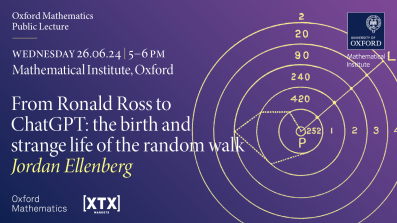17:00
From Ronald Ross to ChatGPT: the birth and strange life of the random walk - Jordan Ellenberg
Between 1905 and 1910 the idea of the random walk, now a major topic in applied maths, was invented simultaneously and independently by multiple people in multiple countries for completely different purposes – in the UK, the story starts with Ronald Ross and the problem of mosquito control, but elsewhere, the theory was being developed in domains from physics to finance to winning a theological argument (really!).
Jordan will tell some part of this story and also gesture at ways that random walks (or Markov processes, named after the theological arguer) underlie current approaches to artificial intelligence; he will touch on some of his own work with DeepMind and speculate about the capabilities of those systems now and in the future.
Jordan Ellenberg is a Professor of Mathematics at the University of Wisconsin-Madison. He is the author of best-selling works of non-fiction and fiction, and has written and lectured extensively for a general audience about the wonders of mathematics for over fifteen years.
Please email @email to register to attend in person.
The lecture will be broadcast on the Oxford Mathematics YouTube Channel on Thursday 18 July at 5-6pm and any time after (no need to register for the online version).
The Oxford Mathematics Public Lectures are generously supported by XTX Markets.

